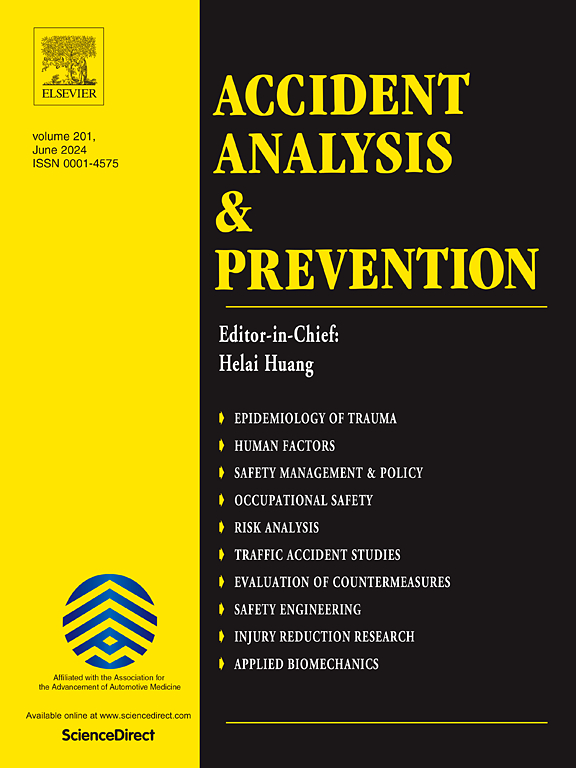Analysis of secondary risks induced by defensive braking in autonomous vehicles: a study based on stochastic distribution of drivers
IF 6.2
1区 工程技术
Q1 ERGONOMICS
引用次数: 0
Abstract
Defensive braking measures in autonomous vehicles effectively enhance driving safety but also raise concerns about the secondary risks they may pose, particularly the potential for rear-end collisions caused by following vehicles. Indeed, being rear-ended by human driven vehicles is already the most common type of accident involving autonomous vehicles. However, the uncertainty in driver following behavior makes it challenging to assess this risk directly. In response, this paper characterizes the stochastic distribution of drivers to simulate and evaluate the impact of defensive braking behavior on the likelihood of rear-end collisions. First, based on Risk Homeostasis Theory and the central limit theorem, we propose the hypothesis that the risk tolerance levels (RTL) of driver populations follow a normal distribution. This hypothesis is validated using the Waymo dataset, leading to the development of a Stochastic Following Model (SFM) that effectively represents the stochastic distribution of drivers. Subsequently, a comparison with the Intelligent Driver Model (IDM) reveals that the SFM not only accurately reflects the stochastic distribution of drivers in mixed traffic flow but also demonstrates its effectiveness in capturing the diversity of driving behaviors. Finally, through the design of simulation experiments across various scenarios using Monte Carlo methods, the results indicate that while brief defensive braking by autonomous vehicles does not significantly affect the collision probability of following vehicles compared to manually driven vehicles, continuous defensive braking behavior substantially increases the likelihood of being rear-ended. The proposed SFM captures the extensive diversity of drivers and the stochasticity of the following process, illustrating the uncertainties inherent in mixed traffic flow. This model may serve as a valuable reference for future studies on the safety characteristics of mixed traffic flows.
基于驾驶员随机分布的自动驾驶汽车防护制动二次风险分析
自动驾驶汽车的防御性制动措施有效地提高了驾驶安全性,但也引起了人们对其可能构成的次要风险的担忧,特别是被跟随车辆引起的追尾碰撞的可能性。事实上,被人类驾驶的车辆追尾已经是自动驾驶汽车最常见的事故类型。然而,驾驶员跟随行为的不确定性使得直接评估这种风险具有挑战性。为此,本文利用驾驶员的随机分布特征来模拟和评估防御性制动行为对追尾碰撞可能性的影响。首先,基于风险稳态理论和中心极限定理,提出了驾驶员总体风险容忍水平服从正态分布的假设。通过使用Waymo数据集验证了这一假设,从而开发了一个随机跟随模型(SFM),该模型有效地代表了驾驶员的随机分布。与智能驾驶员模型(IDM)的对比表明,SFM不仅能准确反映混合交通流中驾驶员的随机分布,而且能有效捕捉驾驶员行为的多样性。最后,利用蒙特卡罗方法设计了不同场景的仿真实验,结果表明,与手动驾驶车辆相比,自动驾驶车辆短暂的防御性制动对跟随车辆的碰撞概率没有显著影响,但持续的防御性制动行为大大增加了被追尾的可能性。所提出的SFM捕捉了驾驶员的广泛多样性和后续过程的随机性,说明了混合交通流固有的不确定性。该模型可为今后研究混合交通流的安全特性提供有价值的参考。
本文章由计算机程序翻译,如有差异,请以英文原文为准。
求助全文
约1分钟内获得全文
求助全文
来源期刊

Accident; analysis and prevention
Multiple-
CiteScore
11.90
自引率
16.90%
发文量
264
审稿时长
48 days
期刊介绍:
Accident Analysis & Prevention provides wide coverage of the general areas relating to accidental injury and damage, including the pre-injury and immediate post-injury phases. Published papers deal with medical, legal, economic, educational, behavioral, theoretical or empirical aspects of transportation accidents, as well as with accidents at other sites. Selected topics within the scope of the Journal may include: studies of human, environmental and vehicular factors influencing the occurrence, type and severity of accidents and injury; the design, implementation and evaluation of countermeasures; biomechanics of impact and human tolerance limits to injury; modelling and statistical analysis of accident data; policy, planning and decision-making in safety.
 求助内容:
求助内容: 应助结果提醒方式:
应助结果提醒方式:


